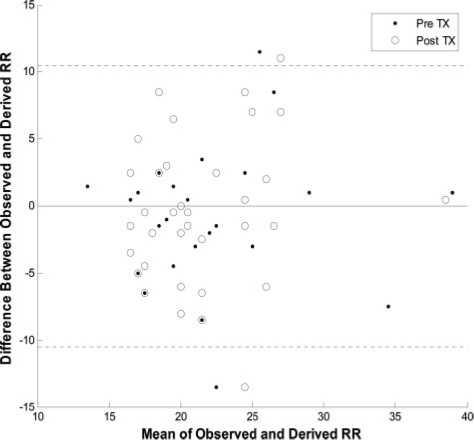
The greater number of patients who had been unnecessarily admitted to the hospital may reflect the conservative approach that many physicians have in the management of asthma. The alternate disposition indicated by AT-PP supports its inclusion as an adjunct tool in patient assessment. Relapsing patients who had been discharged from the hospital are comparatively less […]

Oximetry plethysmography also showed PP-like phenomena, which correspond to the BP measured PP events (Fig 4, top, A). A linear regression model describes a transfer function, which relates AT-PP in units of millimeters of Hg to a decrease in plethys-mographic amplitude (Fig 4, bottom, B). The slope of this relationship is roughly 0.01 V/mm Hg, […]

The interrater reliabilities, as assessed with intraclass correlation, are listed in Table 3. Neither the composite nor any of the subscales met our criterion for reliability (0.80). However, the estimated mean of the composite score did meet our criterion, as did the mean for OD at pretreatment. The mean total score, which was the only […]
The risk ratio was 5.32 for hospital admission among patients with PP, which exceeded this threshold. This is in contrast to the same analysis for the initial AT-PP measurement prior to standardized asthma treatment, in which the mean Wilcoxon AUC-ROC was 0.571 (95% CI, 0.27 to 0.87) [Fig 2, bottom, B, inset). The AT-PP threshold […]

Seventy-nine patients were enrolled in this study from September 2003 to June 2005 as a convenience sample. Nine patients were excluded from the analysis as they failed to meet study asthma criteria following post hoc inspection of both outpatient and inpatient records. Of the remaining 70 patients, 19 (27.1%) were admitted to the hospital from […]
PP was induced in a healthy adult using an established technique by having him breathe through a fixed resistance connected to a two-way nonrebreathing valve (Hans Rudolph; Kansas City, MO) that was attached to a manometer (OEM Medical; Marshalltown, IA). Airflow resistance occurred during inspiration, whereas expiration was unimpeded. The reference subject’s BP and oximetry […]

The cost of appropriate outpatient care was determined in the same way based on one ED visit without patient relapse, which was defined as an unscheduled medical office or ED visit within 72 h of hospital discharge. The cost of inappropriate inpatient care was based on the average cost in 2004 for conditions denoted by […]




